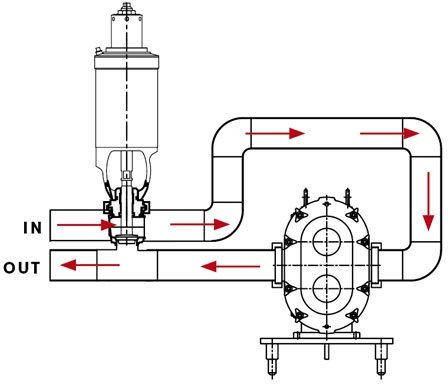Home › General › Accessories

Welcome!
Be part of our community & join our international next generation forum now!
Categories
In this Discussion
- grim March 2016
- jacksonbrown March 2016
- richard March 2016
PRV on a PD Pump plus CIP Bypass
So I know how I would normal do this:

but a want the pump to be reversible.
If the outlet becomes the inlet then the pressure relief is backwards too.
Anyone got an elegant solution for me?


image.jpg
448 x 384 - 20K
Comments
Use two less expensive pressure switches, the prv is a mess, and if you are on a cart with a vfd, wire them to trigger stop.
Or don't use one at all, and don't do something silly like pull vacuum or pump into a closed valve.
Check your PD head to see if it has an integral bypass as well.
Famous last words =))
If I was on a cart I wouldn't need to flow both ways and I want the stem valve for CIP bypass anyway.
I had a bit more of a think about it and I think I worked it out.
I want to investigate the hard pipped/automation option.
@grim you do a lot of grain. What's you fermenter set up. It's the CIP side of things that's got me thinking.
Do you get your spray-balls clogging up? Is there an initial water flush to drain before recirculating that sorts it out?
If I have your terminology correct ... I associate my process as PRV = Pressure Reducing Valve (regulator) and your PD as Positive Displacement pump.
I have no problem with the use of a SEAT valve being used for CIP bypass, this being due to low PD pump flow.
Just not sure what you are trying to achieve.
If you are trying ensure a max line pressure then simply install a pressure relief valve (manual) or automate it with pressure sensor and associated automated valve.
Trying to achieve two things. Over pressure protection and a CIP bypass route as that pump won't be fast enough and I can't pump 'through' it.
PRV = Pressure
ReducingRelief Valve in this case.If you deadhead a PD (positive Displacement) pump bad things happen.
The pump itself will probably be on a VSD to control the flow rate but it's unlikely to be quick enough to CIP the line.
Hence the bypass. There will be a separate pump on the CIP return line to clean. The PD pump will be on during the CIP cycle to clean it but with the bypass open.
If the outlet of the PD pump is under the valve seat you get the added benefit of a pressure relief along with CIP bypass but that only works one way. I started off with a single seat valve as a stop valve at each end of the line that would have done it but they disappeared for various reasons.
My only thought would then install safety relief valves KIESELMANN - Safety valves/Tank fittings
The over pressure scenario is really only on the PD pump discharge, this being due to its low flow and high pressure characteristics.
In any case with the seat valve open during CIP I do not see too much issue of the relief valve's placement. i.e. you will get approximate equal pressure either side of the pump for when pressure does build up. So stick at least one relief on "normal" PD pump's flow / pressure side for when the seat valve is closed.
Both sides are discharge. I'm going into and out of a tank with the same set up.
The valve I was intending is the correct one for the intended purpose, I just couldn't remember what to do when you reverse flow.
I might look into the end of the line solution again. I need a stop valve there anyway.
We rinse down the tanks with water during the end of the pump-over to clean any solids from the tanks, as well as to flush the lines somewhat, any little remainder in the lines just does into the drain before we start. From the fermenter to the still, we would rather have a good flush than leave 5-10 gallons in the hoses.
You know, you could also use the VFD overcorrect protection to stop the pump in an overpressure scenario. Just monitor the average amperage draw and set it one or two tenths higher. The amperage will spike when you dead head.
That said, you need about 30gpm on a 1.5" line, 50gpm on a 2" line - what is your pump size that you think it would be undersized to drive CIP?
I don't have one yet, just doing up process drawings.
Honestly, we just shut the valve and walk over to the pump and turn it off - the gap is maybe 5 seconds. Now, our hoses are pretty damn heavy, Glidetech Distillery - 150psi working, 450psi burst, but unless you are working with something absurd like silicone tube.
Usually, we have two people working at any one time, and most stuff is a two man job, so one person to start/stop the pump while the other works a valve.
I'd put a start/stop control box on a wire before I went out of the way with one of those pressure reliefs, which easily cost a grand.
Everything could be a one man job
So what am I missing then? Just use valve actuators.
You'd need them anyway, and if you are controlling with a PLC or similar, you can easily actuate valves and the pumping with reasonable accuracy.